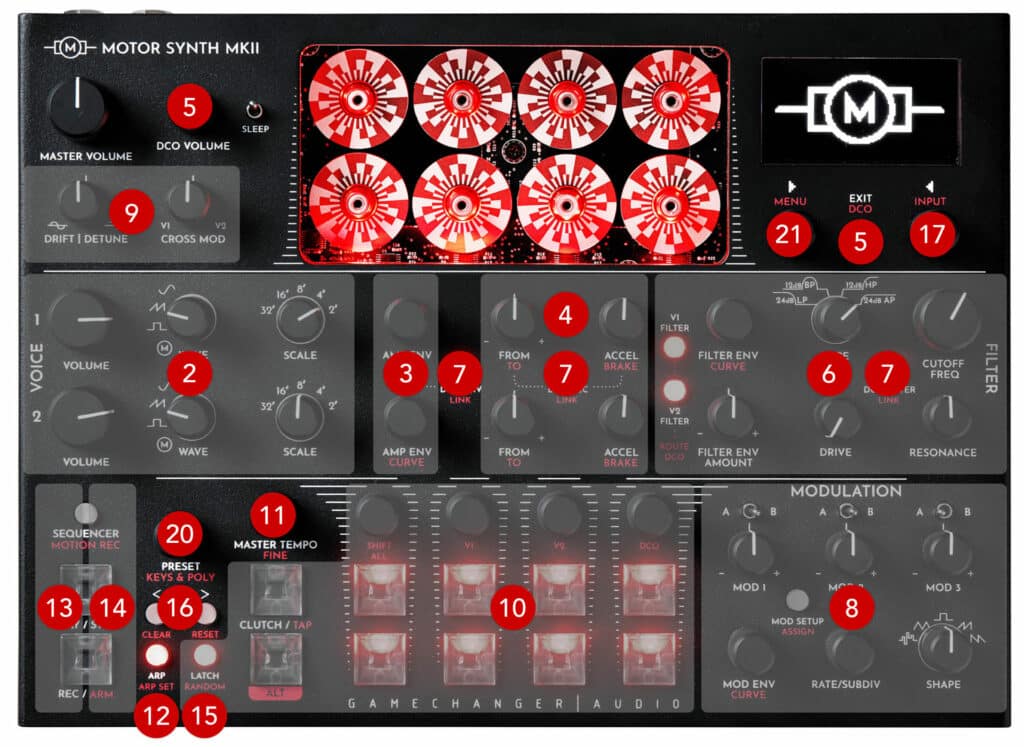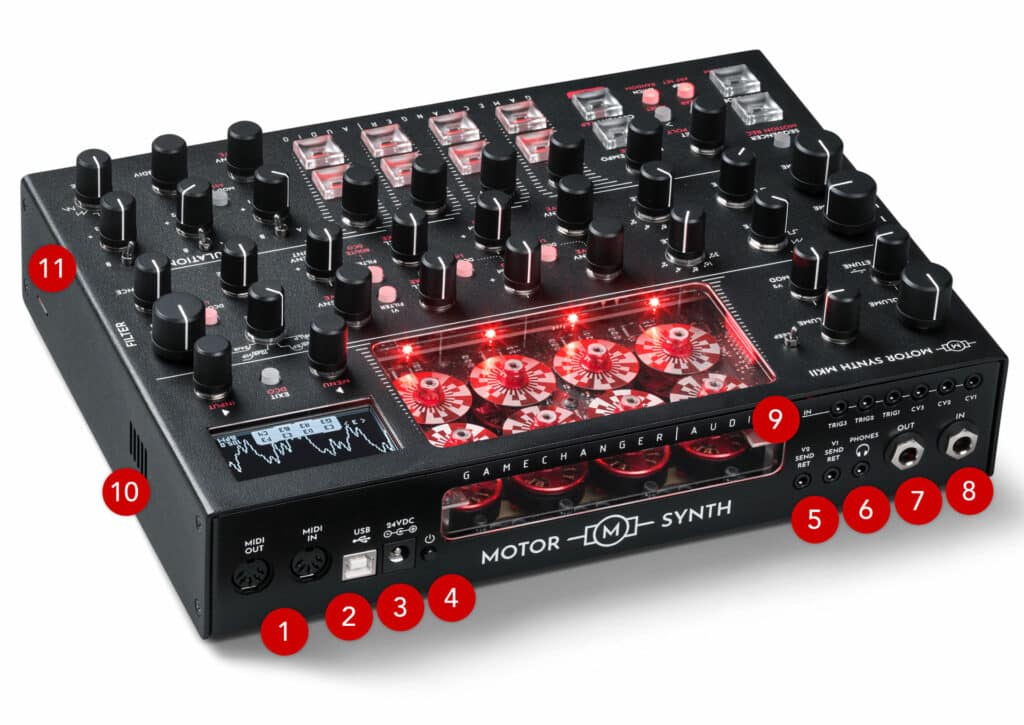USEFUL INFORMATION
CONTACT US
+1 202 657 4587
Gamechanger Audio
Tomsona str 33A
Riga, LV-1013
Latvia
MENU


MOTOR CONTROLS
AMP ENVELOPE
ACCELERATION/BRAKE
DCO
DCO
FILTER
LINK FUNCTIONALITY
LINK FUNCTIONALITY
LINK FUNCTIONALITY
MODULATION
MODULATION EFFECTS
PERFORMANCE INTERFACE
MASTER TEMPO
ARPEGGIATOR
SEQUENCER
MOTION REC
RANDOM
CLEAR AND RESET
INPUT SIGNAL PROCESSING
PRESETS AND PROJECTS
SETTINGS MENU
MIDI IMPLEMENTATION
FIRMWARE UPDATE
The MOTOR SYNTH’s central feature is the innovative ELECTROMOTOR OSCILLATOR SYSTEM. The spinning motors can be used to generate electromagnetic inductive signal (M wave), as well as three types of optical waves (sine, square, saw) via a specially designed system of reflective rotating discs.
Modulating the rotational speed of individual motors enables the creation of musical pitches. The eight MOTOR Oscillator block comprises two MOTOR VOICES, with four Motors per Voice, capable of playing notes either in unison (four motors per note per voice) or with four-note paraphony (due to a single analog filter stage per voice).
In addition to the two MOTOR Voices, the MOTOR Synth includes a third Digital voice known as DCO. This voice consists of four digital oscillators that can be played in unison or with four-note paraphony. Similar to the MOTOR Voices, the DCO Voice also has independently controllable amp and pitch envelope sections, as well as a dedicated multi-mode digital analog filter. However, it also has additional tone-shaping options, including a wider variety of waveshapes, wave folding, pulse width modulation, and hard syncing. The DCO is not the MOTOR Synth’s main feature, but it serves very well for adding precision and tonal range to the MOTOR Oscillators.
Signal produced by the MOTOR Voices is further shaped by two multi-mode analog filters. While the filter control section is shared, all filter parameters for each voice can be adjusted separately, including cutoff, drive, resonance, envelope amount, envelope shape, type etc.
The ability to control each voice’s filter separately is very rarely found in traditional instruments and it offers a huge amount of sound shaping possibilities.
The Digital Voice (DCO) uses a separate digital filter (with shared controls), however it can be easily routed to pass through either of the two analog filters.
The MOTOR Synth’s modulation section is quite advanced and provides a lot of flexibility. It includes three independent modulators with two destination slots each that can be assigned to any of the instrument’s parameters. Each modulator has its own clock source and subdivisions, which can be adjusted independently.
Furthermore, there are extensive waveshaping options available for each modulator, as well as a fully featured multi-mode modulation envelope with adjustable curve, velocity and reset parameters.
The MOTOR Synth offers two types of dedicated performance effect-knobs that can be further fine-tuned in separate menu Screens.
The DRIFT/DETUNE knob gradually introduces subtle variations in the rotational speeds of the motor oscillators, thus creating a very nuanced and powerful analog detune effect.
The CROSS MOD knob allows you to modulate the MOTOR Synth’s output with the frequency and waveshpe of both MOTOR Voices. Depending on the Voice’s settings the resulting Crossmod effect can range from a frenzied, ring-modulated distortion to a gentle, pulsating “broken” sound.
The MOTOR Synth offers a built in performance interface that consists of a non-velocity sensitive 8 key KEYPAD with four rotary PITCH ENCODERS (PITCH ENC). The MOTOR Synth’s Musical Interface is designed for playing basic NOTE sequences in real time, setting up drones, chords and pads, as well as programming the built in ARP and SEQUENCER Engines.
The MOTOR Synth features an extremely flexible Arpeggiator engine that is perfectly suited for live performance with the built in KEYPAD or other external controllers.
The ARP Pattern editor allows you to create endless unique ARP patterns, which can then be saved as presets. The MOTOR Synth has a dedicated bank of ARP-based presets which showcase the engine’s versatility.
The MOTOR Synth offers a built-in Sequencer Engine that allows you to create, save and manage up to 8 melodic PATTERNS per Project.
Patterns can be chained and sequenced (similar to “Song Mode” on other devices).
The pattern editor offers a wide variety of parameters that can be adjusted on a per-step basis, as well as a randomization engine that can be used for creating sequences based on different musical scales and specific sets of rules and probabilities.
The MOTOR Synth is equipped with a powerful motion record engine with eight independent recording lanes, enabling you to capture knob and parameter adjustments in real-time during your performance. You can easily fine-tune the playback speed, direction, and quantization settings for each lane individually. Additionally, you can mute and unmute specific lanes as needed, giving you even more control over your performance.


MIDI OUT & IN
5-pin DIN MIDI output and input
USB
USB type B for data transfer and MIDI output
DC INPUT
Use the included power adapter connected to a power outlet
POWER BUTTON
Turn the unit on and off
V1 & V2 SEND RET
Pre-filter send and return for
MOTOR VOICE 1 and MOTOR VOICE 2 separately.
3.5mm / 1/8 inch unbalanced TRS
(TIP - SEND, RING - RETURN)
PHONES
3.5mm / 1/8 inch unbalanced TRS
OUT
Main audio output.
6.35mm / 1/4 inch unbalanced TRS.
Use a TS cable for mono output
or a TRS cable for split-VOICE output
(TIP - MOTOR VOICE 1, RING - MOTOR VOICE 2).
IN
Audio input.
6.35mm / 1/4 inch unbalanced TS
CV & TRIG IN
3.5mm / 1/8 inch CV and trigger inputs
FAN VENT
Variable speed fan for cooling.
Do not cover the vent.
SD CARD
SD card slot
5-pin DIN MIDI output and input
USB type B for data transfer and MIDI output
3 DC input
Use the included power adapter connected to a power outlet
4 Power button
Turn the unit on and off
5 V1 & V2 SEND RET
Pre-filter send and return for MOTOR VOICE 1 and MOTOR VOICE 2 separately.
3.5mm / 1/8 inch unbalanced TRS (TIP – SEND, RING – RETURN)
6 PHONES
3.5mm / 1/8 inch unbalanced TRS
Main audio output
6.35mm / 1/4 inch unbalanced TRS. Use a TS cable for mono output or a TRS cable for split-VOICE output (TIP – MOTOR VOICE 1, RING – MOTOR VOICE 2)
Audio input
6.35mm / 1/4 inch unbalanced TS
3.5mm / 1/8 inch CV and trigger inputs
10 FAN VENT
Variable speed fan for cooling. Do not cover the vent.
SD card slot
+1 202 657 4587
Gamechanger Audio
Tomsona str 33A
Riga, LV-1013
Latvia